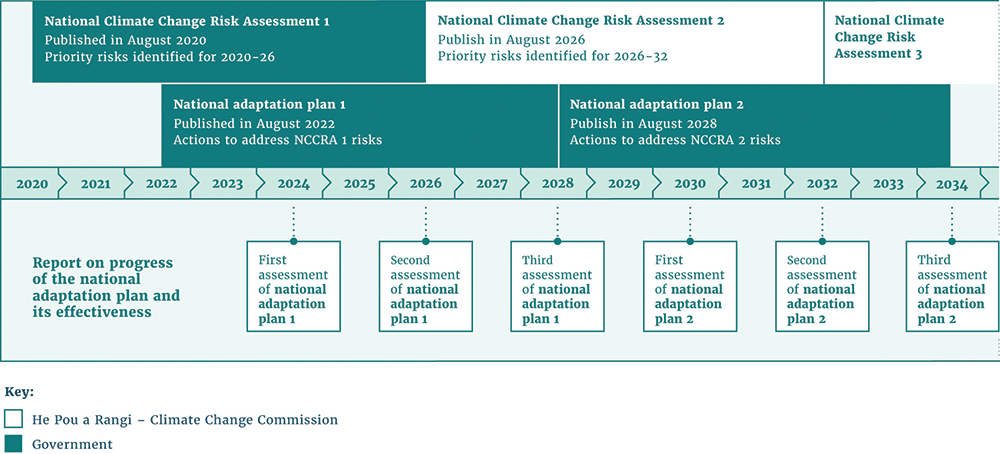Chapter 11 Implementing the plan

The plan was published in 2022. Some actions in the plan were amended in January 2025 as part of the Government's response to the Climate Change Commission's national adaptation plan progress report. These updates reflect changes in circumstances since the plan was published, and align with the Government’s climate strategy.
See the response and updated table of actions for more details.
The actions in this plan are varied and wide-ranging. Different actions aim to support different sectors and entities. During the implementation phase, the extent of engagement will also vary.
Some actions, such as the Aquaculture Strategy or Tourism Industry Transformation Plan, are sector specific. Others, such as the Health National Adaptation Plan, apply more to communities.
Other examples include the regular updates of local government guidance. Engaging with local government will be essential for this, as councils will have the most direct experience of which parts of the guidance work well and which could be strengthened.
Inclusive engagement, particularly with those disproportionately affected by climate change, will help to ensure actions lead to the intended outcomes.
This approach to implementation will align us with the emissions reduction plan’s equitable transition strategy. It will do this by encouraging engaged and active public participation in the plan, including in partnership with Māori.
Every two years, He Pou a Rangi – Climate Change Commission will report to the Minister of Climate Change on the implementation and effectiveness of the national adaptation plan (figure 10). The Minister must respond to these reports within six months of receiving them. This provides an opportunity for the Government to adjust the actions and manage uncertainty and risk. The Government also has international commitments to report on Aotearoa New Zealand’s progress towards building resilience.

The entries on the timeline are:
The timeline also outlines key dates for reporting on progress and effectiveness of the national adaptation plan. These dates are:
The Climate Change Commission is responsible for actions 2, 3, and 7 to 11. The Government is responsible for actions 1, 4 and 5.

The entries on the timeline are:
The timeline also outlines key dates for reporting on progress and effectiveness of the national adaptation plan. These dates are:
The Climate Change Commission is responsible for actions 2, 3, and 7 to 11. The Government is responsible for actions 1, 4 and 5.
Successfully implementing the national adaptation plan will require action across government. Strong governance and accountability mechanisms are needed to make continuous progress. A climate change interdepartmental executive board (IEB) is being established to oversee the emissions reduction plan and national adaptation plan. The IEB will monitor and report on progress each year (annual IEB report). The Climate Change Response Minister’s Group will oversee the plan and drive progress.
Regulatory stewardship (monitoring the Government’s regulatory systems) is a further opportunity to consider climate change and improve how we implement the plan.
Timeframe: Years 1–6 (2022–28)
Lead agency: MfE
Relevant portfolio: Climate Change
Primarily supports: Objective SW1
Status: Current
This will provide transparency of implementation of the plan across government, improve coordination within central government and enable accountability.
Annual reporting requirements by agencies will be completed each year, commencing in 2023.
Each critical and supporting action in this national adaptation plan includes progress indicators to 2028. To help the Commission assess the plan’s effectiveness in reducing risk, the Ministry for the Environment will regularly assess the preparedness of certain organisations. These include policy developers and service providers. The results from the first survey in 2020 set a baseline for assessing the effectiveness of future actions.
Monitoring the progress of the national adaptation plan and reporting on its effectiveness will enable the Government to identify whether it is appropriate to adjust the actions in the plan. The IEB annual report will identify:
Some actions in this plan depend on new or updated data or information. Others need additional knowledge before they can be applied. Additional data may also be needed to inform the next national climate change risk assessment, which will be published in 2026. This research strategy describes the data, information and research needed to fill these gaps.
Across the research themes, the following are steps to prioritise to 2028:
The first three years of this national adaptation plan are key for both collecting the data and information and starting long-term programmes. This will allow data and information to be made available for the second national climate change risk assessment, which will be published in 2026.
During this period, research priorities are to:
Existing and concurrent research should aim to produce and publish results in 2024–25.
The National Science Challenges conclude in 2024. The projects with climate adaptation research are: The Deep South, Resilience to Nature’s Challenges, Our Land and Water, New Zealand’s Biological Heritage, Sustainable Seas, and Building Better Homes, Towns and Cities.
The results will likely be ready in time to inform the second national climate change risk assessment and ongoing national adaptation plan work.
The second national adaptation plan will be published in 2028. Research priorities include:
Research in all areas will build on what has been learned, and address what remains to be known, as knowledge about climate change grows. This requires a commitment to long-term research, including national environmental monitoring and ecosystem studies.
Other actions during this period include:

Chapter 11 Implementing the plan
August 2022
© Ministry for the Environment